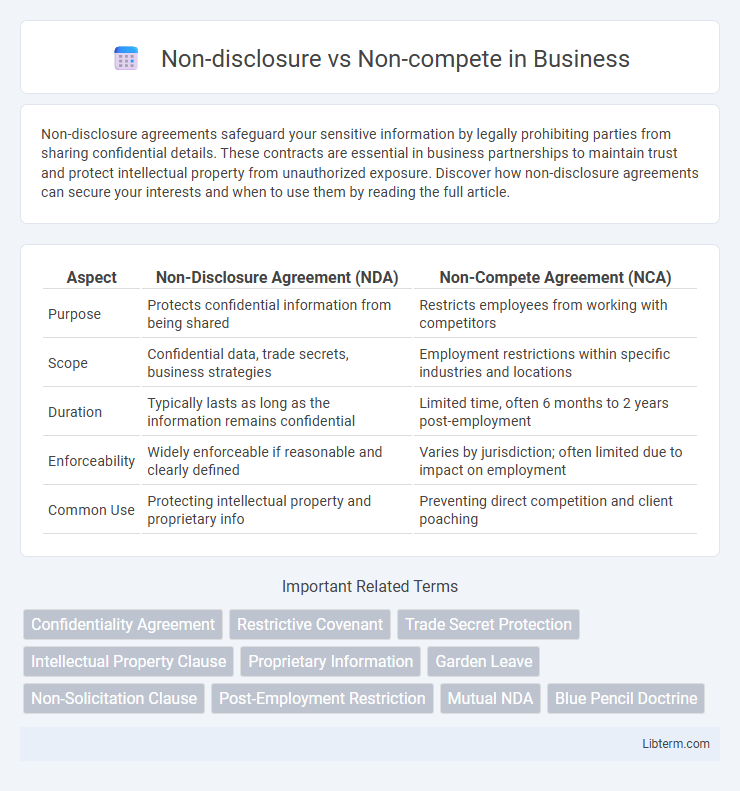Non-disclosure agreements safeguard your sensitive information by legally prohibiting parties from sharing confidential details. These contracts are essential in business partnerships to maintain trust and protect intellectual property from unauthorized exposure. Discover how non-disclosure agreements can secure your interests and when to use them by reading the full article.
Table of Comparison
| Aspect | Non-Disclosure Agreement (NDA) | Non-Compete Agreement (NCA) |
|---|---|---|
| Purpose | Protects confidential information from being shared | Restricts employees from working with competitors |
| Scope | Confidential data, trade secrets, business strategies | Employment restrictions within specific industries and locations |
| Duration | Typically lasts as long as the information remains confidential | Limited time, often 6 months to 2 years post-employment |
| Enforceability | Widely enforceable if reasonable and clearly defined | Varies by jurisdiction; often limited due to impact on employment |
| Common Use | Protecting intellectual property and proprietary info | Preventing direct competition and client poaching |
Understanding Non-Disclosure Agreements (NDAs)
Non-Disclosure Agreements (NDAs) legally bind parties to confidentiality, preventing the sharing of sensitive information such as trade secrets, business strategies, or client data. Unlike Non-Compete Agreements that restrict employment or business activities, NDAs solely focus on information protection without limiting professional mobility. Effective NDAs clearly define the scope of confidential information, duration of the obligation, and permissible disclosures to safeguard proprietary knowledge.
What is a Non-Compete Agreement?
A Non-Compete Agreement is a legally binding contract that restricts an employee or party from engaging in business activities that compete with their employer or former employer for a specified period and within a designated geographic area. It aims to protect trade secrets, confidential information, and maintain competitive advantage by preventing the individual from working with direct competitors or starting a similar business. These agreements often include specific time frames, scope of restricted activities, and geographic boundaries to ensure enforceability and safeguard the company's interests.
Key Differences Between NDAs and Non-Competes
Non-disclosure agreements (NDAs) primarily protect confidential information by legally prohibiting parties from sharing proprietary data, whereas non-compete agreements restrict an individual's ability to engage in competing business activities within a specified geographic area and time frame. NDAs are designed to safeguard trade secrets, customer lists, and sensitive business information, while non-competes aim to prevent unfair competition and protect market position. The enforceability of non-compete clauses varies significantly by jurisdiction, whereas NDAs generally have broader legal acceptance.
Common Clauses in NDAs and Non-Competes
Non-disclosure agreements (NDAs) commonly include clauses specifying the definition of confidential information, obligations of the receiving party to maintain secrecy, and the duration of confidentiality obligations. Non-compete agreements typically contain clauses defining the restricted activities, geographic scope, duration of the non-compete period, and consequences of breach. Both agreements emphasize protecting business interests but differ in scope--NDAs focus on information confidentiality, while non-competes restrict competitive actions.
Legal Enforceability: NDAs vs Non-Competes
Non-disclosure agreements (NDAs) are generally more legally enforceable because they protect confidential information without restricting an individual's right to work, making courts more likely to uphold them. Non-compete agreements, however, face stricter scrutiny and are often limited or deemed unenforceable in many jurisdictions due to their potential to unfairly limit employment opportunities. The enforceability of non-competes depends heavily on factors such as geographic scope, duration, and legitimate business interests.
When to Use an NDA vs a Non-Compete
Use a Non-Disclosure Agreement (NDA) when protecting confidential information, trade secrets, or proprietary data shared between parties during business relationships, partnerships, or employment. Opt for a Non-Compete Agreement when preventing employees or contractors from engaging in competing businesses or working with competitors for a specified time and geographic area after the relationship ends. NDAs safeguard sensitive information, while Non-Compete Agreements restrict competitive activity, making the choice dependent on whether the priority is confidentiality or competition limitation.
Benefits of Non-Disclosure Agreements
Non-disclosure agreements (NDAs) protect sensitive business information by legally preventing parties from sharing proprietary data, thus safeguarding trade secrets and maintaining competitive advantage. They foster trust between companies and employees or partners while minimizing the risk of intellectual property theft and confidential data leaks. NDAs offer flexible terms tailored to specific information types and durations, ensuring effective protection without restricting professional mobility.
Advantages and Risks of Non-Compete Agreements
Non-compete agreements protect businesses by restricting employees from joining competitors or starting similar ventures, preserving trade secrets and customer relationships. However, these agreements carry risks such as limiting employee mobility, which can lead to legal challenges and potential disputes over enforceability depending on jurisdiction. Balancing the advantages of safeguarding competitive advantage with the risk of reduced talent attraction and retention is crucial for companies employing non-compete clauses.
Employee Rights and Protections
Non-disclosure agreements (NDAs) primarily protect sensitive company information, limiting employees from sharing trade secrets or confidential data during and after employment. Non-compete clauses restrict employees from joining or starting competitors within a specific geographic area and timeframe, often impacting job mobility and future employment opportunities. Employee rights and protections vary by jurisdiction, with courts frequently scrutinizing non-compete agreements for reasonableness, while NDAs tend to receive broader enforcement when narrowly tailored to protect legitimate business interests.
Best Practices for Drafting NDAs and Non-Competes
Best practices for drafting NDAs emphasize clear definitions of confidential information, specific duration limits, and tailored scope to protect proprietary data without overreaching. Non-compete agreements require careful consideration of geographic boundaries, reasonable time frames, and legitimate business interests to ensure enforceability and fairness. Both NDAs and non-competes benefit from precise language, compliance with applicable state laws, and thorough explanation to involved parties to mitigate legal risks.
Non-disclosure Infographic

 libterm.com
libterm.com